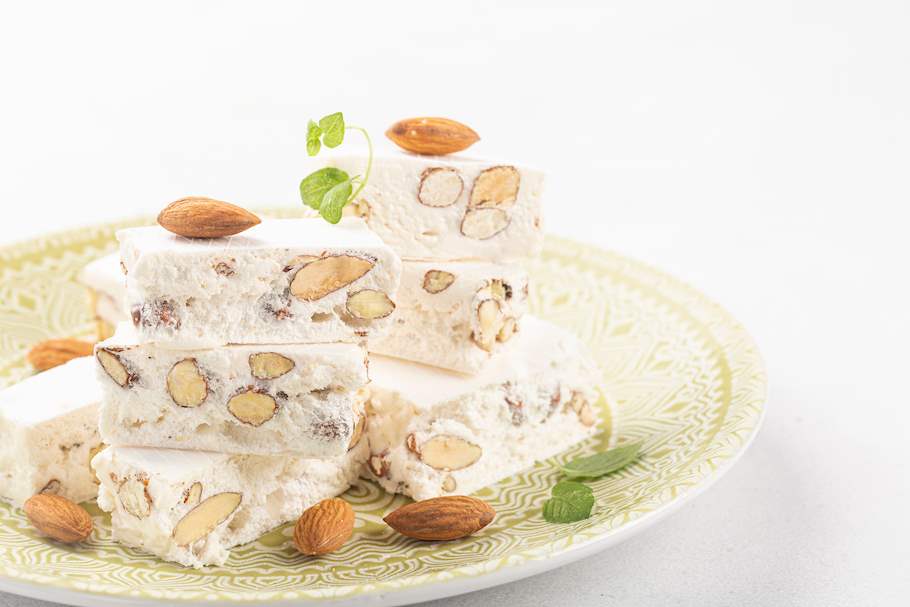Authentic Torrone Recipe Italy, Europe
JUMP TO RECIPEWe strongly advise you to read the cooking tips before jumping to the recipe though
Introduction & history
Present in every corner of Italy, the Italian nougat or torrone usually comes in the form of bars and is made with honey, sugar, egg whites, and toasted nuts, usually almonds, hazelnuts, and pistachio. Its texture can range from soft and chewy (torrone morbido or torrone tenero), to hard and brittle (torrone duro), which is determined by the length of cooking. Apart from the basic ingredients, the torrone can also include chocolate, dried or candied fruit, orange or lemon zest, other nuts such as walnuts or sesame seeds, and glucose syrup. The preparation is simple, but in most cases, quite time-consuming. The first step is to toast the nuts, which can be left whole or chopped coarsely. Honey and sugar are melted in separate bowls over a bain-marie — the honey should become liquid, while the sugar should be brought to the point of caramelization. The honey and sugar syrup are then joined, mixed with whipped egg whites and preferred nuts, and cooked.... Read more
Pair with
Cooking tips
-
nuts
Almonds and hazelnuts are the two types of nuts most commonly used in the Italian torrone, although walnuts, pistachios, and peanuts often appear in recipes. In most cases, the nuts should be toasted in an oven — 5 minutes at 170ºC is enough. If the recipe calls for blanched nuts, simply soak them shortly in boiling water, cool them, and remove the skin using your fingers. -
honey
Most torrone recipes suggest using sweet and lightly colored honey varieties, such as acacia or millefiori. Honey can be partially substituted with sugar syrup or glucose syrup and should be melted slowly over a bain-marie until it becomes completely liquid. -
egg whites
If the recipe for the torrone calls for egg whites, whip them into a firm snow, and fold them gently into the melted honey and sugar syrup. -
wafer paper
Also known as ostia, these edible sheets are widely available in stores, but can also be prepared at home. Flour, water, and olive oil are mixed and cooked on a stovetop, then poured into a flat mold and baked shortly in an oven. Wafer paper is placed on the bottom and the top side of the hot torrone to prevent it from sticking, and it does not need to be removed before consumption. -
cooking
The cooking time can vary from just a few minutes to 8 hours, and the mixture should be stirred constantly, preferably with a wooden spoon. Traditional recipes suggest making the torrone in a copper cooking pan because copper has the ability to increase or decrease its temperature quickly, which can help prevent the torrone mixture from burning. However, stainless steel cooking pans can be used as ... Read more -
shaping
There are two ways to shape the torrone properly. The hot torrone mixture can be poured into a wooden rectangular mold or a non-stick baking pan, which should be lined with wafer paper. The mixture is then flattened evenly with a metal spatula, so it is 1 to 3 cm thick, and then left to cool. Alternatively, the hot mixture can be poured onto a marble slab and flattened with a rolling pin. If you prefer ... Read more -
cutting and storing
Let the torrone cool slightly, but not completely, before cutting. Oil a sharp knife and insert it straight down into the torrone. Wipe and oil the knife after each slice, and store the torrone in an airtight container or a tin box.
Recipe variations
Lombard Torrone from Cremona
PREP 15min
COOK 1h
READY IN 1h 15min
Probably the most famous version of torrone comes from the city of Cremona in the Lombardy region in Northern Italy. This recipe was adapted from in-lombardia.it and suggests using either almonds or hazelnuts, and flavoring the torrone with vanilla sugar and lemon zest.
Ingredients
Lombard Torrone from Cremona
20 wafer papers
200 g sugar
200 g honey
50 ml water
500 g hazelnuts or almonds
1 sachet vanilla sugar
2 egg whites
zest from 1 lemon
Preparation
Lombard Torrone from Cremona
Mix water with sugar over low heat until it caramelizes.
Meanwhile, roast the hazelnuts or almonds.
Melt the honey in a bain-marie. Add caramel and roasted hazelnuts or almonds.
Whip the egg whites into a firm snow and gently fold them into the honey, caramel, and nuts mixture. Cook over low heat for 1 hour.
Line a shallow, non-stick baking pan with wafer paper and pour in the torrone mixture. Distribute evenly and flatten, so it is about 2 cm high.
Lay another sheet of wafer paper on top and wait for the torrone to cool down, then serve or store for later use.
Other Variations
Other authentic recipes











Rating And Comments
Rate It
Wanna try?
Add To List